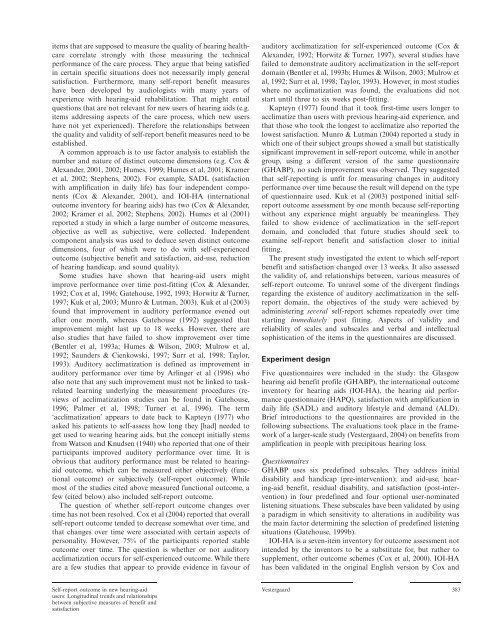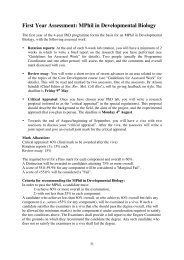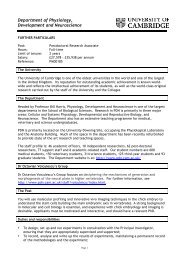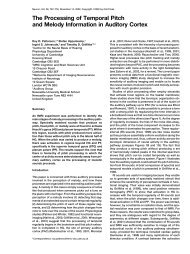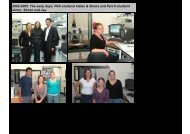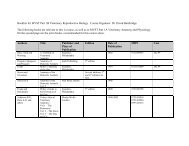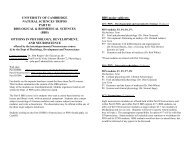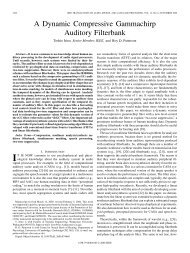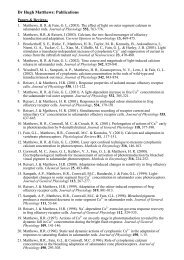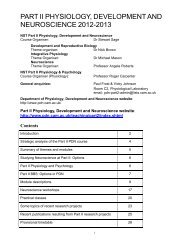Self-report outcome in new hearing-aid users - Department of ...
Self-report outcome in new hearing-aid users - Department of ...
Self-report outcome in new hearing-aid users - Department of ...
You also want an ePaper? Increase the reach of your titles
YUMPU automatically turns print PDFs into web optimized ePapers that Google loves.
items that are supposed to measure the quality <strong>of</strong> hear<strong>in</strong>g healthcare<br />
correlate strongly with those measur<strong>in</strong>g the technical<br />
performance <strong>of</strong> the care process. They argue that be<strong>in</strong>g satisfied<br />
<strong>in</strong> certa<strong>in</strong> specific situations does not necessarily imply general<br />
satisfaction. Furthermore, many self-<strong>report</strong> benefit measures<br />
have been developed by audiologists with many years <strong>of</strong><br />
experience with hear<strong>in</strong>g-<strong>aid</strong> rehabilitation. That might entail<br />
questions that are not relevant for <strong>new</strong> <strong>users</strong> <strong>of</strong> hear<strong>in</strong>g <strong>aid</strong>s (e.g.<br />
items address<strong>in</strong>g aspects <strong>of</strong> the care process, which <strong>new</strong> <strong>users</strong><br />
have not yet experienced). Therefore the relationships between<br />
the quality and validity <strong>of</strong> self-<strong>report</strong> benefit measures need to be<br />
established.<br />
A common approach is to use factor analysis to establish the<br />
number and nature <strong>of</strong> dist<strong>in</strong>ct <strong>outcome</strong> dimensions (e.g. Cox &<br />
Alexander, 2001, 2002; Humes, 1999; Humes et al, 2001; Kramer<br />
et al, 2002; Stephens, 2002). For example, SADL (satisfaction<br />
with amplification <strong>in</strong> daily life) has four <strong>in</strong>dependent components<br />
(Cox & Alexander, 2001), and IOI-HA (<strong>in</strong>ternational<br />
<strong>outcome</strong> <strong>in</strong>ventory for hear<strong>in</strong>g <strong>aid</strong>s) has two (Cox & Alexander,<br />
2002; Kramer et al, 2002; Stephens, 2002). Humes et al (2001)<br />
<strong>report</strong>ed a study <strong>in</strong> which a large number <strong>of</strong> <strong>outcome</strong> measures,<br />
objective as well as subjective, were collected. Independent<br />
component analysis was used to deduce seven dist<strong>in</strong>ct <strong>outcome</strong><br />
dimensions, four <strong>of</strong> which were to do with self-experienced<br />
<strong>outcome</strong> (subjective benefit and satisfaction, <strong>aid</strong>-use, reduction<br />
<strong>of</strong> hear<strong>in</strong>g handicap, and sound quality).<br />
Some studies have shown that hear<strong>in</strong>g-<strong>aid</strong> <strong>users</strong> might<br />
improve performance over time post-fitt<strong>in</strong>g (Cox & Alexander,<br />
1992; Cox et al, 1996; Gatehouse, 1992, 1993; Horwitz & Turner,<br />
1997; Kuk et al, 2003; Munro & Lutman, 2003). Kuk et al (2003)<br />
found that improvement <strong>in</strong> auditory performance evened out<br />
after one month, whereas Gatehouse (1992) suggested that<br />
improvement might last up to 18 weeks. However, there are<br />
also studies that have failed to show improvement over time<br />
(Bentler et al, 1993a; Humes & Wilson, 2003; Mulrow et al,<br />
1992; Saunders & Cienkowski, 1997; Surr et al, 1998; Taylor,<br />
1993). Auditory acclimatization is def<strong>in</strong>ed as improvement <strong>in</strong><br />
auditory performance over time by Arl<strong>in</strong>ger et al (1996) who<br />
also note that any such improvement must not be l<strong>in</strong>ked to taskrelated<br />
learn<strong>in</strong>g underly<strong>in</strong>g the measurement procedures (reviews<br />
<strong>of</strong> acclimatization studies can be found <strong>in</strong> Gatehouse,<br />
1996; Palmer et al, 1998; Turner et al, 1996). The term<br />
‘acclimatization’ appears to date back to Kapteyn (1977) who<br />
asked his patients to self-assess how long they [had] needed to<br />
get used to wear<strong>in</strong>g hear<strong>in</strong>g <strong>aid</strong>s, but the concept <strong>in</strong>itially stems<br />
from Watson and Knudsen (1940) who <strong>report</strong>ed that one <strong>of</strong> their<br />
participants improved auditory performance over time. It is<br />
obvious that auditory performance must be related to hear<strong>in</strong>g<strong>aid</strong><br />
<strong>outcome</strong>, which can be measured either objectively (functional<br />
<strong>outcome</strong>) or subjectively (self-<strong>report</strong> <strong>outcome</strong>). While<br />
most <strong>of</strong> the studies cited above measured functional <strong>outcome</strong>, a<br />
few (cited below) also <strong>in</strong>cluded self-<strong>report</strong> <strong>outcome</strong>.<br />
The question <strong>of</strong> whether self-<strong>report</strong> <strong>outcome</strong> changes over<br />
time has not been resolved. Cox et al (2004) <strong>report</strong>ed that overall<br />
self-<strong>report</strong> <strong>outcome</strong> tended to decrease somewhat over time, and<br />
that changes over time were associated with certa<strong>in</strong> aspects <strong>of</strong><br />
personality. However, 75% <strong>of</strong> the participants <strong>report</strong>ed stable<br />
<strong>outcome</strong> over time. The question is whether or not auditory<br />
acclimatization occurs for self-experienced <strong>outcome</strong>. While there<br />
are a few studies that appear to provide evidence <strong>in</strong> favour <strong>of</strong><br />
auditory acclimatization for self-experienced <strong>outcome</strong> (Cox &<br />
Alexander, 1992; Horwitz & Turner, 1997), several studies have<br />
failed to demonstrate auditory acclimatization <strong>in</strong> the self-<strong>report</strong><br />
doma<strong>in</strong> (Bentler et al, 1993b; Humes & Wilson, 2003; Mulrow et<br />
al, 1992; Surr et al, 1998; Taylor, 1993). However, <strong>in</strong> most studies<br />
where no acclimatization was found, the evaluations did not<br />
start until three to six weeks post-fitt<strong>in</strong>g.<br />
Kapteyn (1977) found that it took first-time <strong>users</strong> longer to<br />
acclimatize than <strong>users</strong> with previous hear<strong>in</strong>g-<strong>aid</strong> experience, and<br />
that those who took the longest to acclimatize also <strong>report</strong>ed the<br />
lowest satisfaction. Munro & Lutman (2004) <strong>report</strong>ed a study <strong>in</strong><br />
which one <strong>of</strong> their subject groups showed a small but statistically<br />
significant improvement <strong>in</strong> self-<strong>report</strong> <strong>outcome</strong>, while <strong>in</strong> another<br />
group, us<strong>in</strong>g a different version <strong>of</strong> the same questionnaire<br />
(GHABP), no such improvement was observed. They suggested<br />
that self-<strong>report</strong><strong>in</strong>g is unfit for measur<strong>in</strong>g changes <strong>in</strong> auditory<br />
performance over time because the result will depend on the type<br />
<strong>of</strong> questionnaire used. Kuk et al (2003) postponed <strong>in</strong>itial self<strong>report</strong><br />
<strong>outcome</strong> assessment by one month because self-<strong>report</strong><strong>in</strong>g<br />
without any experience might arguably be mean<strong>in</strong>gless. They<br />
failed to show evidence <strong>of</strong> acclimatization <strong>in</strong> the self-<strong>report</strong><br />
doma<strong>in</strong>, and concluded that future studies should seek to<br />
exam<strong>in</strong>e self-<strong>report</strong> benefit and satisfaction closer to <strong>in</strong>itial<br />
fitt<strong>in</strong>g.<br />
The present study <strong>in</strong>vestigated the extent to which self-<strong>report</strong><br />
benefit and satisfaction changed over 13 weeks. It also assessed<br />
the validity <strong>of</strong>, and relationships between, various measures <strong>of</strong><br />
self-<strong>report</strong> <strong>outcome</strong>. To unravel some <strong>of</strong> the divergent f<strong>in</strong>d<strong>in</strong>gs<br />
regard<strong>in</strong>g the existence <strong>of</strong> auditory acclimatization <strong>in</strong> the self<strong>report</strong><br />
doma<strong>in</strong>, the objectives <strong>of</strong> the study were achieved by<br />
adm<strong>in</strong>ister<strong>in</strong>g several self-<strong>report</strong> schemes repeatedly over time<br />
start<strong>in</strong>g immediately post fitt<strong>in</strong>g. Aspects <strong>of</strong> validity and<br />
reliability <strong>of</strong> scales and subscales and verbal and <strong>in</strong>tellectual<br />
sophistication <strong>of</strong> the items <strong>in</strong> the questionnaires are discussed.<br />
Experiment design<br />
Five questionnaires were <strong>in</strong>cluded <strong>in</strong> the study: the Glasgow<br />
hear<strong>in</strong>g <strong>aid</strong> benefit pr<strong>of</strong>ile (GHABP), the <strong>in</strong>ternational <strong>outcome</strong><br />
<strong>in</strong>ventory for hear<strong>in</strong>g <strong>aid</strong>s (IOI-HA), the hear<strong>in</strong>g <strong>aid</strong> performance<br />
questionnaire (HAPQ), satisfaction with amplification <strong>in</strong><br />
daily life (SADL) and auditory lifestyle and demand (ALD).<br />
Brief <strong>in</strong>troductions to the questionnaires are provided <strong>in</strong> the<br />
follow<strong>in</strong>g subsections. The evaluations took place <strong>in</strong> the framework<br />
<strong>of</strong> a larger-scale study (Vestergaard, 2004) on benefits from<br />
amplification <strong>in</strong> people with precipitous hear<strong>in</strong>g loss.<br />
Questionnaires<br />
GHABP uses six predef<strong>in</strong>ed subscales. They address <strong>in</strong>itial<br />
disability and handicap (pre-<strong>in</strong>tervention); and <strong>aid</strong>-use, hear<strong>in</strong>g-<strong>aid</strong><br />
benefit, residual disability, and satisfaction (post-<strong>in</strong>tervention)<br />
<strong>in</strong> four predef<strong>in</strong>ed and four optional user-nom<strong>in</strong>ated<br />
listen<strong>in</strong>g situations. These subscales have been validated by us<strong>in</strong>g<br />
a paradigm <strong>in</strong> which sensitivity to alterations <strong>in</strong> audibility was<br />
the ma<strong>in</strong> factor determ<strong>in</strong><strong>in</strong>g the selection <strong>of</strong> predef<strong>in</strong>ed listen<strong>in</strong>g<br />
situations (Gatehouse, 1999b).<br />
IOI-HA is a seven-item <strong>in</strong>ventory for <strong>outcome</strong> assessment not<br />
<strong>in</strong>tended by the <strong>in</strong>ventors to be a substitute for, but rather to<br />
supplement, other <strong>outcome</strong> schemes (Cox et al, 2000). IOI-HA<br />
has been validated <strong>in</strong> the orig<strong>in</strong>al English version by Cox and<br />
<strong>Self</strong>-<strong>report</strong> <strong>outcome</strong> <strong>in</strong> <strong>new</strong> hear<strong>in</strong>g-<strong>aid</strong><br />
<strong>users</strong>: Longitud<strong>in</strong>al trends and relationships<br />
between subjective measures <strong>of</strong> benefit and<br />
satisfaction<br />
Vestergaard 383


